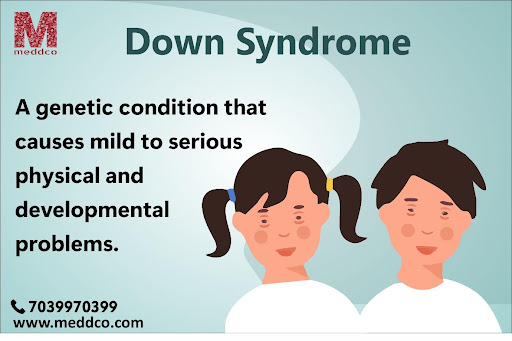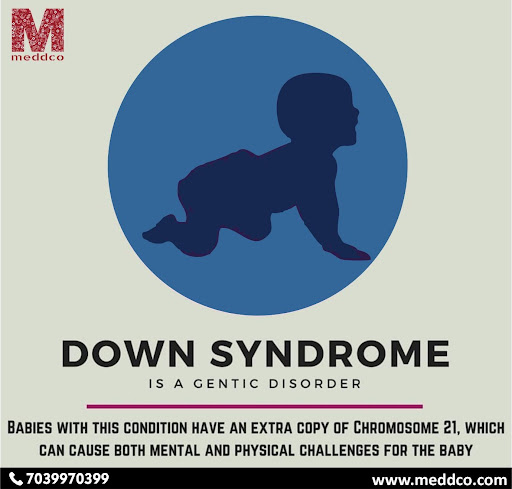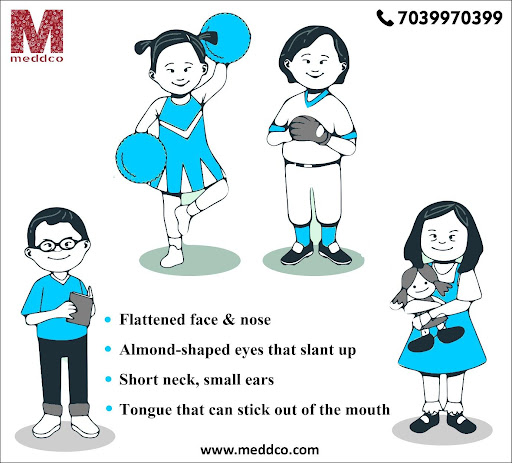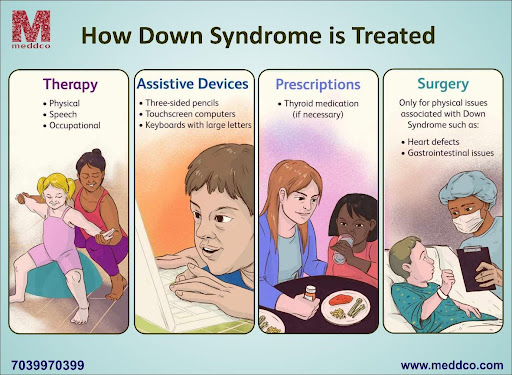Down syndrome is a genetic disorder caused when abnormal cell division results in an extra full or partial copy of chromosome 21. Chromosomes are small “packages” of genes in the body. They determine how a baby’s body forms and functions as it grows during pregnancy and after birth. Typically, a baby is born with 46 chromosomes. Babies with Down syndrome have an extra copy of one of these chromosomes, chromosome 21. This extra genetic material causes the developmental changes and physical features of Down syndrome. A medical term for having an extra copy of a chromosome is ‘trisomy.’ Down syndrome is also referred to as Trisomy 21. This extra copy changes how the baby’s body and brain develop, which can cause both mental and physical challenges for the baby.
Down syndrome varies in severity among individuals, causing lifelong intellectual disability and developmental delays. It’s the most common genetic chromosomal disorder and cause of learning disabilities in children. It also commonly causes other medical abnormalities, including heart and gastrointestinal disorders.
.Symptoms Of Down Syndrome
Down syndrome or Down’s syndrome, also known as trisomy 21, is a genetic disorder caused by the presence of all or part of a third copy of chromosome 21. It is usually associated with physical growth delays, mild to moderate intellectual disability, and characteristic facial features. The average IQ of a young adult with Down syndrome is 50, equivalent to the mental ability of an eight- or nine-year-old child, but this can vary widely.
Each person with Down syndrome is an individual or intellectual and developmental problems may be mild, moderate or severe. Some people are healthy while others have significant health problems such as serious heart defects. Children and adults with Down syndrome have distinct facial features. Though not all people with Down syndrome have the same features, some of the more common features include: Flattened face, small head, short neck, protruding tongue, upward slanting eye lids (palpebral fissures), Unusually shaped or small ears, Poor muscle tone, Broad, short hands with a single crease in the palm, relatively short fingers and small hands and feet, Excessive flexibility, Tiny white spots on the coloured part (iris) of the eye called Bushfield’s spots and short height.
Facts And Myths Related To Down Syndrome
There are many myths about Down syndrome and we are pondering to debunk them. Down syndrome is not a disease or illness, it’s when someone is born with an extra copy of chromosome 21 in their DNA be it full or partial. In some parts of the country, there are over 13,000 people with the disability that is almost about 1 in 270 people. Down syndrome is a genetic condition that causes mild to serious physical and developmental problems. Here are 30 interesting facts about Down Syndrome that will blow your mind!
- Down syndrome is named after John Langdon Down. The British physician first described Down syndrome in 1866, but he didn’t know what caused the tell-tale symptoms. Indeed, experts didn’t understand the chromosomal basis until French physician Jérôme LeJeune discovered it in 1959.
- Down syndrome (DS) is a genetic condition where a person is born with an extra copy of chromosome 21. Experts are still trying to figure out why some babies inherit an extra copy of chromosome 21 and others don’t. Genetics possibly plays a role in less than 1 percent of Down syndrome cases, according to the National Down Syndrome Society. A baby’s chances also seem to increase with advanced maternal age, but the link isn’t fully understood. Down syndrome tends to happen unpredictably, and there’s nothing parents can do to prevent it.

- The exact cause of the extra chromosome that triggers Down syndrome is unknown. Down syndrome is the most common chromosomal condition. According to the Centres for Disease Control and Prevention (CDC), about 6,000 American babies are born with Down syndrome each year. Researchers also estimated that 250,700 people were living with Down syndrome in 2008.
- People with Down syndrome have a greater risk of certain health conditions. One of the most common is congenital heart defects; they affect about half of children with Down syndrome, but they can often be corrected through surgery. Other common complications include obstructive sleep apnea, vision impairment, hearing loss, immune disorders, gastrointestinal problems, and thyroid problems.
- There are more than 400,000 people living with Down syndrome According to the Centres for Disease Control and Prevention (CDC), about 6,000 babies are born with Down syndrome each year. Researchers also estimated that 250,700 people were living with Down syndrome in 2008.
- In 1983, the average life expectancy of a person with Down syndrome was a mere 25-years-old. Today, it’s 60. According to Dr. Rosenbaum, Down syndrome previously had a 10 percent mortality rate in the baby’s first year. But thanks to medical advancements and a better understanding of the condition, many people with Down syndrome can expect to live at least 60 years nowadays.
- Children and adults with Down syndrome share some common features, but naturally the individuals will more closely resemble their immediate family members.
- Since the 1970s, public schools are required by law to provide a free and appropriate education to children with Down syndrome. Down syndrome often causes learning disabilities, speech and language delays, and other intellectual symptoms but the severity differs for everyone. Some children with Down syndrome enrol in special education classes, while others perform well in mainstream classrooms. Most people have mild to moderate intellectual impairments.
- It is estimated that 5,000 children are born with Down syndrome in India alone.
- The likelihood of giving birth to a child with Down syndrome increases with maternal age, however, 80% of babies with Down syndrome are born to women under 35 years of age because this age group gives birth most frequently.
- People with Down syndrome die young. This one used to be true but it has been seen that in 1910, a child born with Down syndrome often passed away before his or her 10th birthday. Fast forward 100 years, the life expectancy of people with Down syndrome has increased dramatically. These days, many people with Down syndrome live into their 60s, and some even live well into their 80s.
- Down syndrome remains the most common chromosomal condition diagnosed in the United States. Each year, about 6,000 babies born in the United States have Down syndrome. This means that Down syndrome occurs in about 1 in every 700 babies.
- October month is considered as Down Syndrome Awareness Month. October celebrates Down syndrome and raises awareness for the genetic disorder.
- While behaviour, mental ability, and physical development varies from person to person, many individuals with Down syndrome grow up to hold jobs, live independently, and enjoy normal recreational activities.
- There are three types of Down syndrome. About 95 percent of Down syndrome cases are Trisomy 21, which is characterized by an extra copy of chromosome 21 in every cell. About 3 to 4 percent of people have translocation Down syndrome; in addition to two copies of chromosome 21 like normal, they have a full or partial extra chromosome 21 attached to an entirely different chromosome, for example, chromosome 14. The least common form is mosaic Down syndrome, in which some cells have two copies of chromosome 21 and others have three copies.

- Down syndrome can be diagnosed before birth. First and second trimester screenings, which usually involve a blood test and an ultrasound, give a probability that your child will have Down syndrome. Prenatal diagnostic tests like chorionic villus sampling (CVS) and amniocentesis can predict Down syndrome with greater precision.
- Children with Down syndrome go through the same stages of development as typical children do. The difference we can see while we can Compare to their peers is that, it takes kids with Down syndrome longer to achieve milestones. Things like rolling over, sitting, crawling, walking, talking, etc.
- There isn’t a treatment for Down syndrome. Down syndrome is a lifelong condition that can’t be treated. But one’s child can live a fulfilling life with proper assistance, whether it’s in the form of speciality doctors, early intervention services, occupational therapy, speech therapy, physical therapy, or special needs classes.
- Life expectancy is on the rise. According to Dr. Rosenbaum, Down syndrome previously had a 10 percent mortality rate in the baby’s first year. But thanks to medical advancements and a better understanding of the condition, many people with Down syndrome can expect to live at least 60 years nowadays.
- People don’t have “mild” Down syndrome, or “severe” Down syndrome. Ability is not dependent on the condition, but rather the individual. People either have Down syndrome or they don’t.
- Contrary to popular belief, people with Down syndrome are not always happy. The myth isn’t right. They experience every emotion we do.
- All people with Down syndrome experience cognitive delays, but the effect is usually mild to moderate and is not indicative of the many strengths and talents that each individual possesses.
- A person’s facial features do not determine cognitive ability. Just because someone has many of the characteristic physical feature of Down syndrome does not mean they have a lower IQ. Just because someone has soft features of Down syndrome does not mean their IQ is higher.
- While incidences of Down syndrome correlate with the mother’s age, around 80% of Down syndrome babies are born to mothers under the age of 35.
- People don’t “suffer” from Down syndrome. In a study conducted by Brian Skotko, 99% of adults with Down syndrome reported they were happy with their lives.
- People with Down syndrome have an increased risk for certain medical conditions such as congenital heart defects, respiratory and hearing problems, Alzheimer’s disease, childhood leukaemia, and thyroid conditions. Many of these conditions are now treatable, so most people with Down syndrome lead healthy lives.
- Most people with Down syndrome share physical characteristics. While each individual with Down syndrome displays different symptoms, certain physical characteristics are common. They include flattened face; short stature; slanted almond-shaped eyes; low muscle tone; a crease across the palm of the hand; small hands and feet; tiny ears; short neck; white spots on the irises of the eye; protruding tongue; and small pinkish fingers that might curve.
- There isn’t a treatment for Down syndrome. Down syndrome is a lifelong condition that can’t be treated. But one’s child can live a fulfilling life with proper assistance, whether it’s in the form of speciality doctors, early intervention services, occupational therapy, speech therapy, physical therapy, or special needs classes.
- Down syndrome occurs regularly in both sexes and across socioeconomic classes. In a sample of 75 children with trisomy for chromosome 21, or Down syndrome, there were 42 males and 33 females. The sex ratio was 1.30 which is statistically not significant.
- People with Down syndrome attend school, work, participate in decisions that affect them, have meaningful relationships, vote, and contribute to society in many wonderful ways. Quality educational programs, a stimulating home environment, good health care, and positive support from family, friends, and the community enable people with Down syndrome to lead fulfilling and productive lives.

Conclusion
Down syndrome is a genetic condition that causes delays in physical and intellectual development. It occurs in 1 in every 792 live births. Individuals with Down syndrome have 47 chromosomes instead of the usual 46. It is the most frequently occurring chromosomal disorder. Down syndrome is not related to race, nationality, religion or socioeconomic status. The most important fact to know about individuals with Down syndrome is that they are more like others than they are different.
Down syndrome is still a little-understood disorder. While researchers are aware of what this condition is, we know little about what causes it or how symptoms develop. There is hope that future research can lead mitigation of some symptoms.
MEDDCO.COM is India’s first digital pricing online platform, where price transparency is the key.
Our website allows users to search for surgical procedure diagnostic tests and other healthcare services amongst various hospitals and a healthcare provider.
On our website, you can find the best package price for Down syndrome.
You can also book an online appointment through our website.
For more information visit our website.




